Civil Engineering Technology Report: Site Safety and Design Analysis
VerifiedAdded on 2022/09/14
|17
|3851
|23
Report
AI Summary
This report, prepared for a Civil Engineering Technology course, delves into various aspects of construction. It begins with an executive summary and an introduction to earthworks, detailing equipment like excavators, loaders, and rollers, and techniques such as site clearing, excavation, transportation, and compaction. The report then explores foundation, pile, and drainage works, specifically cast-in-situ pile foundations, and methods for culvert and underpass construction. It also covers excavation methods for deep foundations, focusing on maintaining ground and slope stability through proper drainage, retaining walls, and biotechnical stabilization. The second task addresses health hazards, risks, and safety in construction, including safety plans, risk assessments, and relevant legislation. The report also includes an evaluation of potential project management solutions, considering environmental, quality, geotechnical, and economic contexts, as well as a proposal formulation. Finally, the report concludes with a section on highway design and foundations.
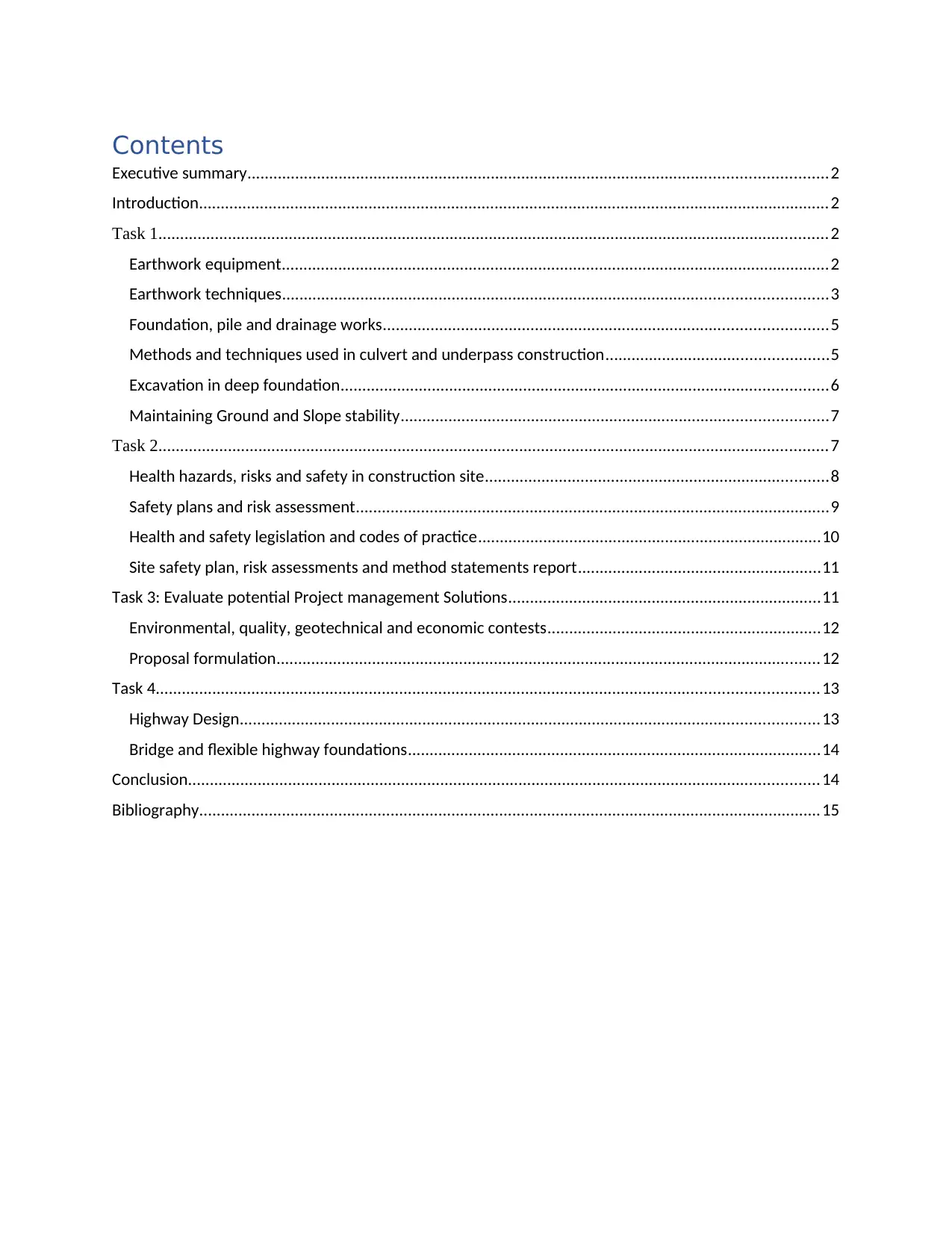
Contents
Executive summary.....................................................................................................................................2
Introduction.................................................................................................................................................2
Task 1..........................................................................................................................................................2
Earthwork equipment..............................................................................................................................2
Earthwork techniques.............................................................................................................................3
Foundation, pile and drainage works......................................................................................................5
Methods and techniques used in culvert and underpass construction...................................................5
Excavation in deep foundation................................................................................................................6
Maintaining Ground and Slope stability..................................................................................................7
Task 2..........................................................................................................................................................7
Health hazards, risks and safety in construction site...............................................................................8
Safety plans and risk assessment.............................................................................................................9
Health and safety legislation and codes of practice...............................................................................10
Site safety plan, risk assessments and method statements report........................................................11
Task 3: Evaluate potential Project management Solutions........................................................................11
Environmental, quality, geotechnical and economic contests...............................................................12
Proposal formulation.............................................................................................................................12
Task 4........................................................................................................................................................13
Highway Design.....................................................................................................................................13
Bridge and flexible highway foundations...............................................................................................14
Conclusion.................................................................................................................................................14
Bibliography...............................................................................................................................................15
Executive summary.....................................................................................................................................2
Introduction.................................................................................................................................................2
Task 1..........................................................................................................................................................2
Earthwork equipment..............................................................................................................................2
Earthwork techniques.............................................................................................................................3
Foundation, pile and drainage works......................................................................................................5
Methods and techniques used in culvert and underpass construction...................................................5
Excavation in deep foundation................................................................................................................6
Maintaining Ground and Slope stability..................................................................................................7
Task 2..........................................................................................................................................................7
Health hazards, risks and safety in construction site...............................................................................8
Safety plans and risk assessment.............................................................................................................9
Health and safety legislation and codes of practice...............................................................................10
Site safety plan, risk assessments and method statements report........................................................11
Task 3: Evaluate potential Project management Solutions........................................................................11
Environmental, quality, geotechnical and economic contests...............................................................12
Proposal formulation.............................................................................................................................12
Task 4........................................................................................................................................................13
Highway Design.....................................................................................................................................13
Bridge and flexible highway foundations...............................................................................................14
Conclusion.................................................................................................................................................14
Bibliography...............................................................................................................................................15
Paraphrase This Document
Need a fresh take? Get an instant paraphrase of this document with our AI Paraphraser
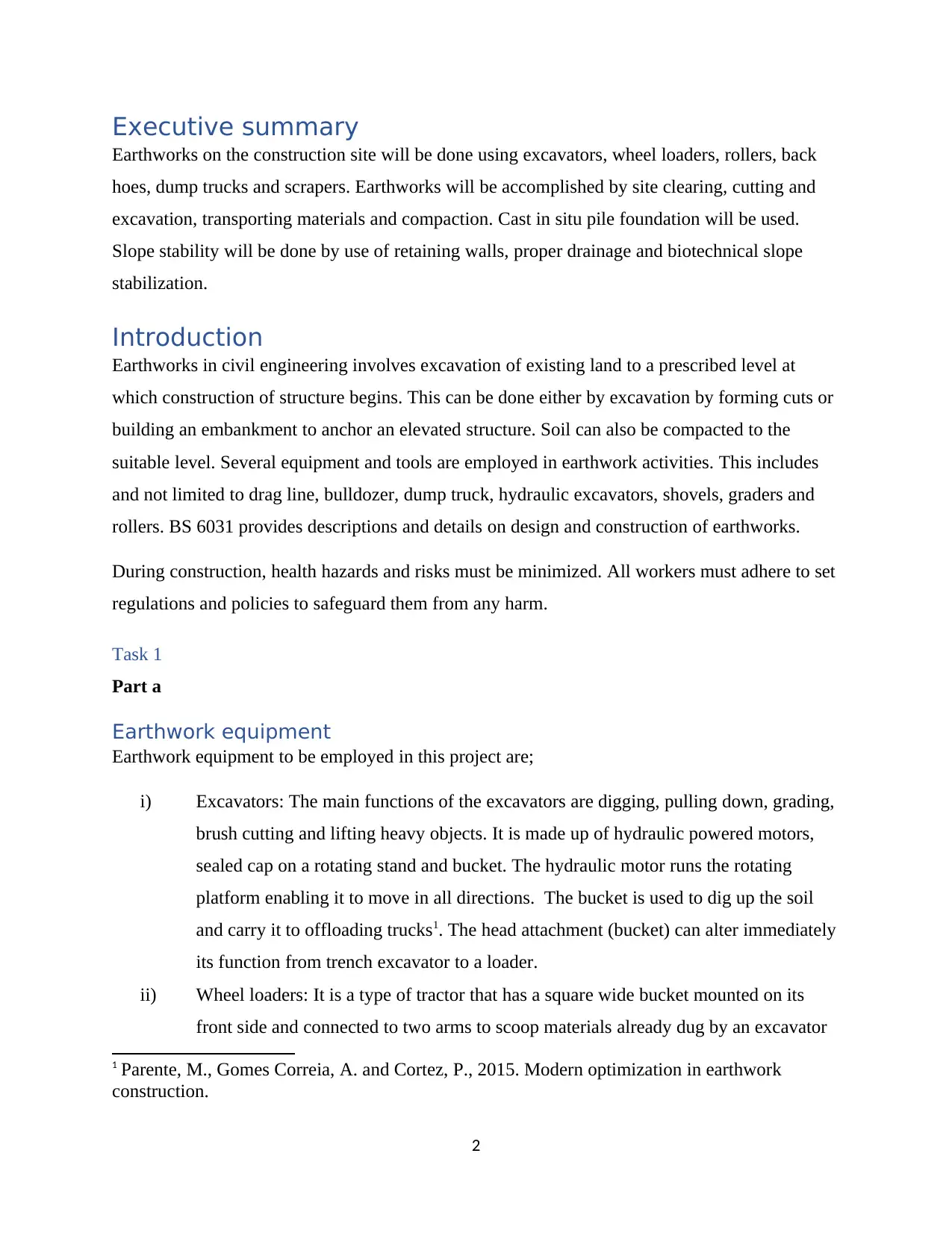
Executive summary
Earthworks on the construction site will be done using excavators, wheel loaders, rollers, back
hoes, dump trucks and scrapers. Earthworks will be accomplished by site clearing, cutting and
excavation, transporting materials and compaction. Cast in situ pile foundation will be used.
Slope stability will be done by use of retaining walls, proper drainage and biotechnical slope
stabilization.
Introduction
Earthworks in civil engineering involves excavation of existing land to a prescribed level at
which construction of structure begins. This can be done either by excavation by forming cuts or
building an embankment to anchor an elevated structure. Soil can also be compacted to the
suitable level. Several equipment and tools are employed in earthwork activities. This includes
and not limited to drag line, bulldozer, dump truck, hydraulic excavators, shovels, graders and
rollers. BS 6031 provides descriptions and details on design and construction of earthworks.
During construction, health hazards and risks must be minimized. All workers must adhere to set
regulations and policies to safeguard them from any harm.
Task 1
Part a
Earthwork equipment
Earthwork equipment to be employed in this project are;
i) Excavators: The main functions of the excavators are digging, pulling down, grading,
brush cutting and lifting heavy objects. It is made up of hydraulic powered motors,
sealed cap on a rotating stand and bucket. The hydraulic motor runs the rotating
platform enabling it to move in all directions. The bucket is used to dig up the soil
and carry it to offloading trucks1. The head attachment (bucket) can alter immediately
its function from trench excavator to a loader.
ii) Wheel loaders: It is a type of tractor that has a square wide bucket mounted on its
front side and connected to two arms to scoop materials already dug by an excavator
1 Parente, M., Gomes Correia, A. and Cortez, P., 2015. Modern optimization in earthwork
construction.
2
Earthworks on the construction site will be done using excavators, wheel loaders, rollers, back
hoes, dump trucks and scrapers. Earthworks will be accomplished by site clearing, cutting and
excavation, transporting materials and compaction. Cast in situ pile foundation will be used.
Slope stability will be done by use of retaining walls, proper drainage and biotechnical slope
stabilization.
Introduction
Earthworks in civil engineering involves excavation of existing land to a prescribed level at
which construction of structure begins. This can be done either by excavation by forming cuts or
building an embankment to anchor an elevated structure. Soil can also be compacted to the
suitable level. Several equipment and tools are employed in earthwork activities. This includes
and not limited to drag line, bulldozer, dump truck, hydraulic excavators, shovels, graders and
rollers. BS 6031 provides descriptions and details on design and construction of earthworks.
During construction, health hazards and risks must be minimized. All workers must adhere to set
regulations and policies to safeguard them from any harm.
Task 1
Part a
Earthwork equipment
Earthwork equipment to be employed in this project are;
i) Excavators: The main functions of the excavators are digging, pulling down, grading,
brush cutting and lifting heavy objects. It is made up of hydraulic powered motors,
sealed cap on a rotating stand and bucket. The hydraulic motor runs the rotating
platform enabling it to move in all directions. The bucket is used to dig up the soil
and carry it to offloading trucks1. The head attachment (bucket) can alter immediately
its function from trench excavator to a loader.
ii) Wheel loaders: It is a type of tractor that has a square wide bucket mounted on its
front side and connected to two arms to scoop materials already dug by an excavator
1 Parente, M., Gomes Correia, A. and Cortez, P., 2015. Modern optimization in earthwork
construction.
2
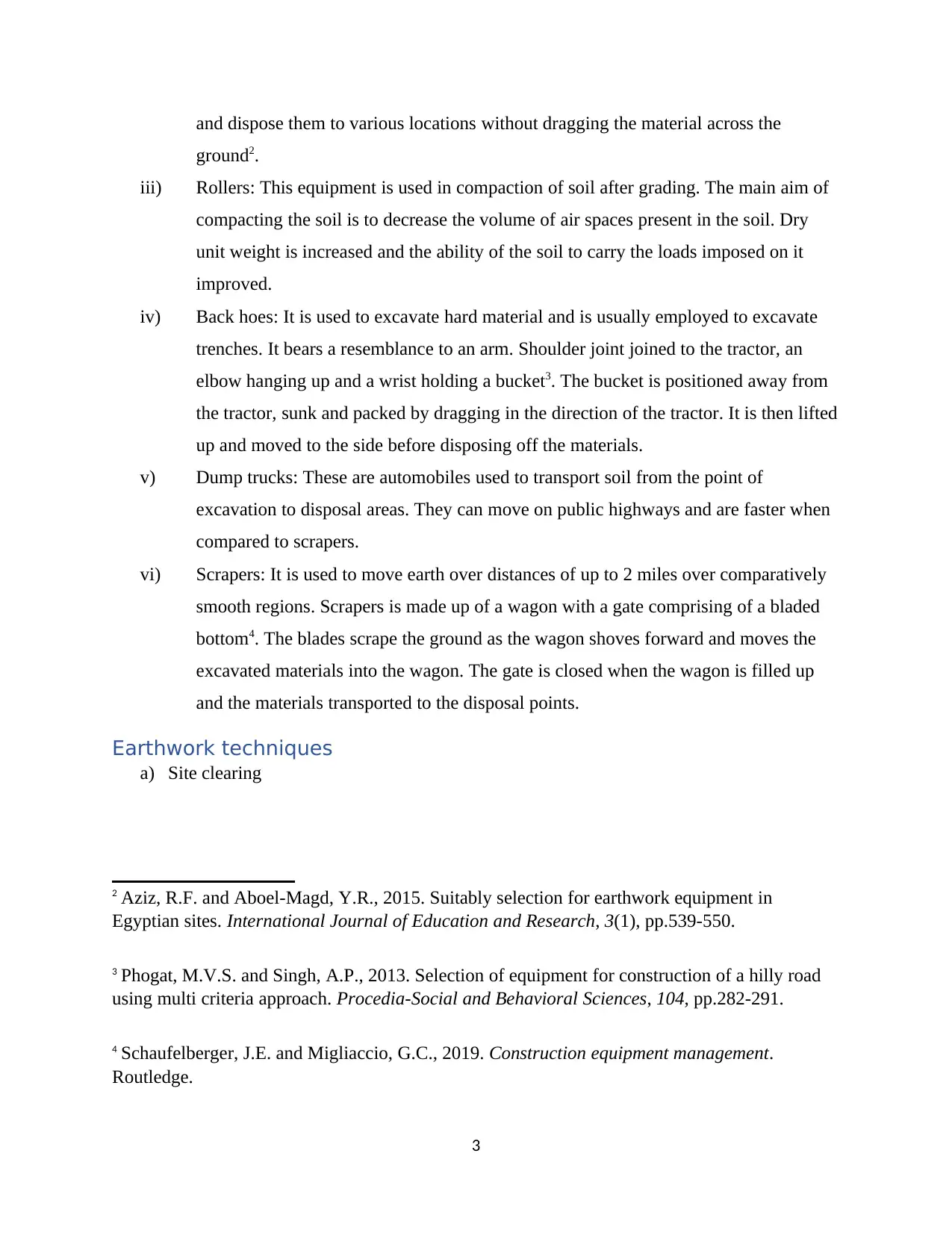
and dispose them to various locations without dragging the material across the
ground2.
iii) Rollers: This equipment is used in compaction of soil after grading. The main aim of
compacting the soil is to decrease the volume of air spaces present in the soil. Dry
unit weight is increased and the ability of the soil to carry the loads imposed on it
improved.
iv) Back hoes: It is used to excavate hard material and is usually employed to excavate
trenches. It bears a resemblance to an arm. Shoulder joint joined to the tractor, an
elbow hanging up and a wrist holding a bucket3. The bucket is positioned away from
the tractor, sunk and packed by dragging in the direction of the tractor. It is then lifted
up and moved to the side before disposing off the materials.
v) Dump trucks: These are automobiles used to transport soil from the point of
excavation to disposal areas. They can move on public highways and are faster when
compared to scrapers.
vi) Scrapers: It is used to move earth over distances of up to 2 miles over comparatively
smooth regions. Scrapers is made up of a wagon with a gate comprising of a bladed
bottom4. The blades scrape the ground as the wagon shoves forward and moves the
excavated materials into the wagon. The gate is closed when the wagon is filled up
and the materials transported to the disposal points.
Earthwork techniques
a) Site clearing
2 Aziz, R.F. and Aboel-Magd, Y.R., 2015. Suitably selection for earthwork equipment in
Egyptian sites. International Journal of Education and Research, 3(1), pp.539-550.
3 Phogat, M.V.S. and Singh, A.P., 2013. Selection of equipment for construction of a hilly road
using multi criteria approach. Procedia-Social and Behavioral Sciences, 104, pp.282-291.
4 Schaufelberger, J.E. and Migliaccio, G.C., 2019. Construction equipment management.
Routledge.
3
ground2.
iii) Rollers: This equipment is used in compaction of soil after grading. The main aim of
compacting the soil is to decrease the volume of air spaces present in the soil. Dry
unit weight is increased and the ability of the soil to carry the loads imposed on it
improved.
iv) Back hoes: It is used to excavate hard material and is usually employed to excavate
trenches. It bears a resemblance to an arm. Shoulder joint joined to the tractor, an
elbow hanging up and a wrist holding a bucket3. The bucket is positioned away from
the tractor, sunk and packed by dragging in the direction of the tractor. It is then lifted
up and moved to the side before disposing off the materials.
v) Dump trucks: These are automobiles used to transport soil from the point of
excavation to disposal areas. They can move on public highways and are faster when
compared to scrapers.
vi) Scrapers: It is used to move earth over distances of up to 2 miles over comparatively
smooth regions. Scrapers is made up of a wagon with a gate comprising of a bladed
bottom4. The blades scrape the ground as the wagon shoves forward and moves the
excavated materials into the wagon. The gate is closed when the wagon is filled up
and the materials transported to the disposal points.
Earthwork techniques
a) Site clearing
2 Aziz, R.F. and Aboel-Magd, Y.R., 2015. Suitably selection for earthwork equipment in
Egyptian sites. International Journal of Education and Research, 3(1), pp.539-550.
3 Phogat, M.V.S. and Singh, A.P., 2013. Selection of equipment for construction of a hilly road
using multi criteria approach. Procedia-Social and Behavioral Sciences, 104, pp.282-291.
4 Schaufelberger, J.E. and Migliaccio, G.C., 2019. Construction equipment management.
Routledge.
3
⊘ This is a preview!⊘
Do you want full access?
Subscribe today to unlock all pages.

Trusted by 1+ million students worldwide
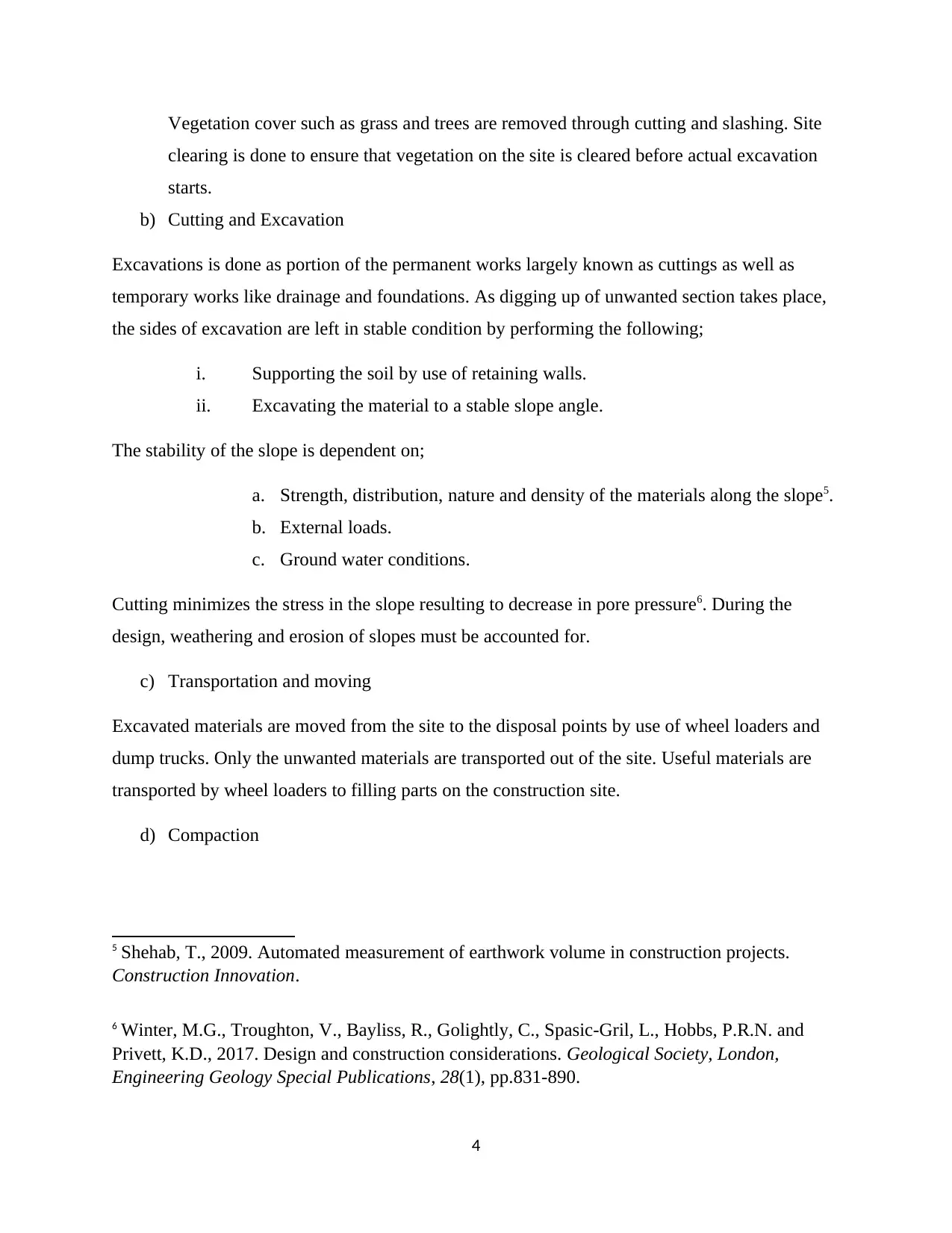
Vegetation cover such as grass and trees are removed through cutting and slashing. Site
clearing is done to ensure that vegetation on the site is cleared before actual excavation
starts.
b) Cutting and Excavation
Excavations is done as portion of the permanent works largely known as cuttings as well as
temporary works like drainage and foundations. As digging up of unwanted section takes place,
the sides of excavation are left in stable condition by performing the following;
i. Supporting the soil by use of retaining walls.
ii. Excavating the material to a stable slope angle.
The stability of the slope is dependent on;
a. Strength, distribution, nature and density of the materials along the slope5.
b. External loads.
c. Ground water conditions.
Cutting minimizes the stress in the slope resulting to decrease in pore pressure6. During the
design, weathering and erosion of slopes must be accounted for.
c) Transportation and moving
Excavated materials are moved from the site to the disposal points by use of wheel loaders and
dump trucks. Only the unwanted materials are transported out of the site. Useful materials are
transported by wheel loaders to filling parts on the construction site.
d) Compaction
5 Shehab, T., 2009. Automated measurement of earthwork volume in construction projects.
Construction Innovation.
6 Winter, M.G., Troughton, V., Bayliss, R., Golightly, C., Spasic-Gril, L., Hobbs, P.R.N. and
Privett, K.D., 2017. Design and construction considerations. Geological Society, London,
Engineering Geology Special Publications, 28(1), pp.831-890.
4
clearing is done to ensure that vegetation on the site is cleared before actual excavation
starts.
b) Cutting and Excavation
Excavations is done as portion of the permanent works largely known as cuttings as well as
temporary works like drainage and foundations. As digging up of unwanted section takes place,
the sides of excavation are left in stable condition by performing the following;
i. Supporting the soil by use of retaining walls.
ii. Excavating the material to a stable slope angle.
The stability of the slope is dependent on;
a. Strength, distribution, nature and density of the materials along the slope5.
b. External loads.
c. Ground water conditions.
Cutting minimizes the stress in the slope resulting to decrease in pore pressure6. During the
design, weathering and erosion of slopes must be accounted for.
c) Transportation and moving
Excavated materials are moved from the site to the disposal points by use of wheel loaders and
dump trucks. Only the unwanted materials are transported out of the site. Useful materials are
transported by wheel loaders to filling parts on the construction site.
d) Compaction
5 Shehab, T., 2009. Automated measurement of earthwork volume in construction projects.
Construction Innovation.
6 Winter, M.G., Troughton, V., Bayliss, R., Golightly, C., Spasic-Gril, L., Hobbs, P.R.N. and
Privett, K.D., 2017. Design and construction considerations. Geological Society, London,
Engineering Geology Special Publications, 28(1), pp.831-890.
4
Paraphrase This Document
Need a fresh take? Get an instant paraphrase of this document with our AI Paraphraser
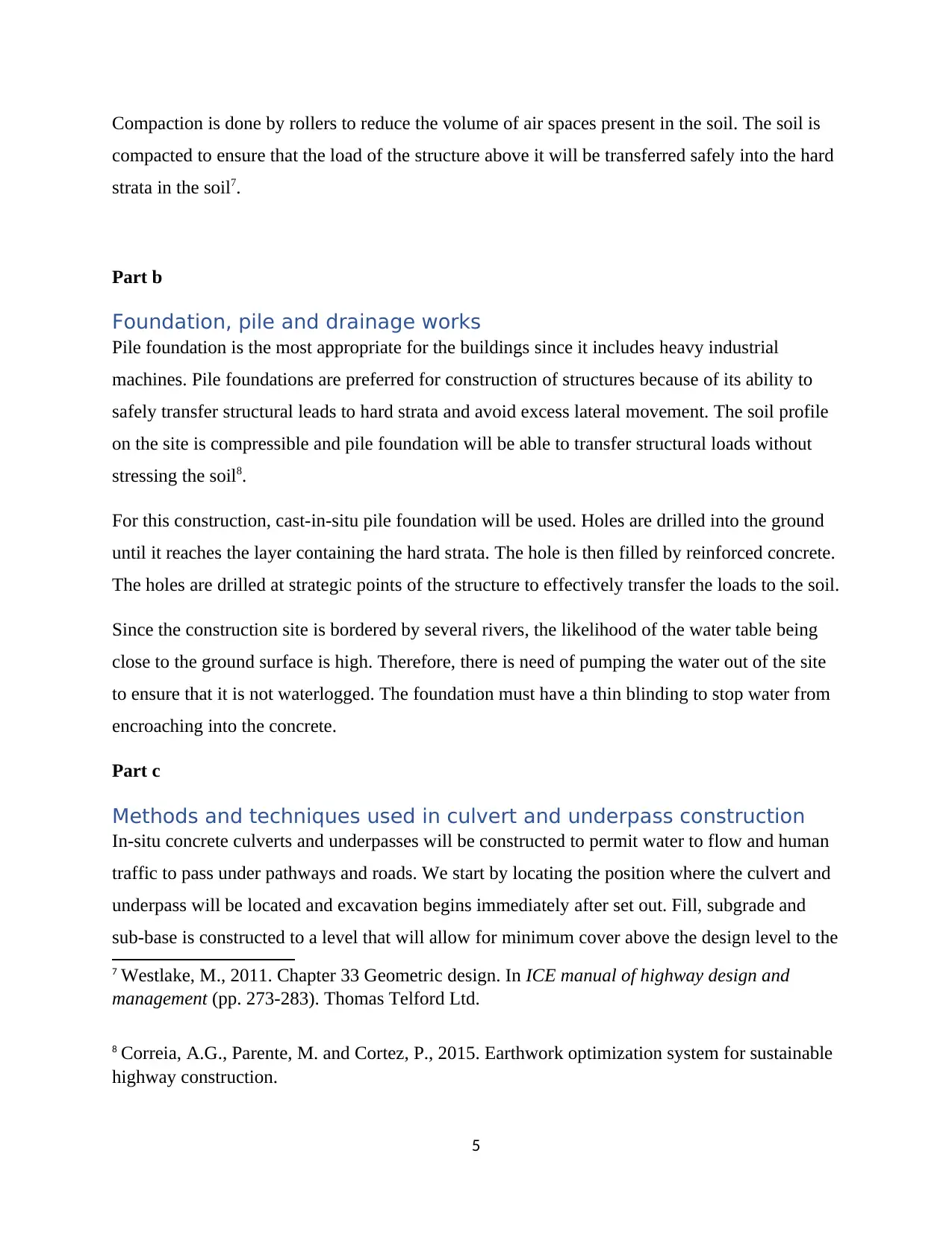
Compaction is done by rollers to reduce the volume of air spaces present in the soil. The soil is
compacted to ensure that the load of the structure above it will be transferred safely into the hard
strata in the soil7.
Part b
Foundation, pile and drainage works
Pile foundation is the most appropriate for the buildings since it includes heavy industrial
machines. Pile foundations are preferred for construction of structures because of its ability to
safely transfer structural leads to hard strata and avoid excess lateral movement. The soil profile
on the site is compressible and pile foundation will be able to transfer structural loads without
stressing the soil8.
For this construction, cast-in-situ pile foundation will be used. Holes are drilled into the ground
until it reaches the layer containing the hard strata. The hole is then filled by reinforced concrete.
The holes are drilled at strategic points of the structure to effectively transfer the loads to the soil.
Since the construction site is bordered by several rivers, the likelihood of the water table being
close to the ground surface is high. Therefore, there is need of pumping the water out of the site
to ensure that it is not waterlogged. The foundation must have a thin blinding to stop water from
encroaching into the concrete.
Part c
Methods and techniques used in culvert and underpass construction
In-situ concrete culverts and underpasses will be constructed to permit water to flow and human
traffic to pass under pathways and roads. We start by locating the position where the culvert and
underpass will be located and excavation begins immediately after set out. Fill, subgrade and
sub-base is constructed to a level that will allow for minimum cover above the design level to the
7 Westlake, M., 2011. Chapter 33 Geometric design. In ICE manual of highway design and
management (pp. 273-283). Thomas Telford Ltd.
8 Correia, A.G., Parente, M. and Cortez, P., 2015. Earthwork optimization system for sustainable
highway construction.
5
compacted to ensure that the load of the structure above it will be transferred safely into the hard
strata in the soil7.
Part b
Foundation, pile and drainage works
Pile foundation is the most appropriate for the buildings since it includes heavy industrial
machines. Pile foundations are preferred for construction of structures because of its ability to
safely transfer structural leads to hard strata and avoid excess lateral movement. The soil profile
on the site is compressible and pile foundation will be able to transfer structural loads without
stressing the soil8.
For this construction, cast-in-situ pile foundation will be used. Holes are drilled into the ground
until it reaches the layer containing the hard strata. The hole is then filled by reinforced concrete.
The holes are drilled at strategic points of the structure to effectively transfer the loads to the soil.
Since the construction site is bordered by several rivers, the likelihood of the water table being
close to the ground surface is high. Therefore, there is need of pumping the water out of the site
to ensure that it is not waterlogged. The foundation must have a thin blinding to stop water from
encroaching into the concrete.
Part c
Methods and techniques used in culvert and underpass construction
In-situ concrete culverts and underpasses will be constructed to permit water to flow and human
traffic to pass under pathways and roads. We start by locating the position where the culvert and
underpass will be located and excavation begins immediately after set out. Fill, subgrade and
sub-base is constructed to a level that will allow for minimum cover above the design level to the
7 Westlake, M., 2011. Chapter 33 Geometric design. In ICE manual of highway design and
management (pp. 273-283). Thomas Telford Ltd.
8 Correia, A.G., Parente, M. and Cortez, P., 2015. Earthwork optimization system for sustainable
highway construction.
5
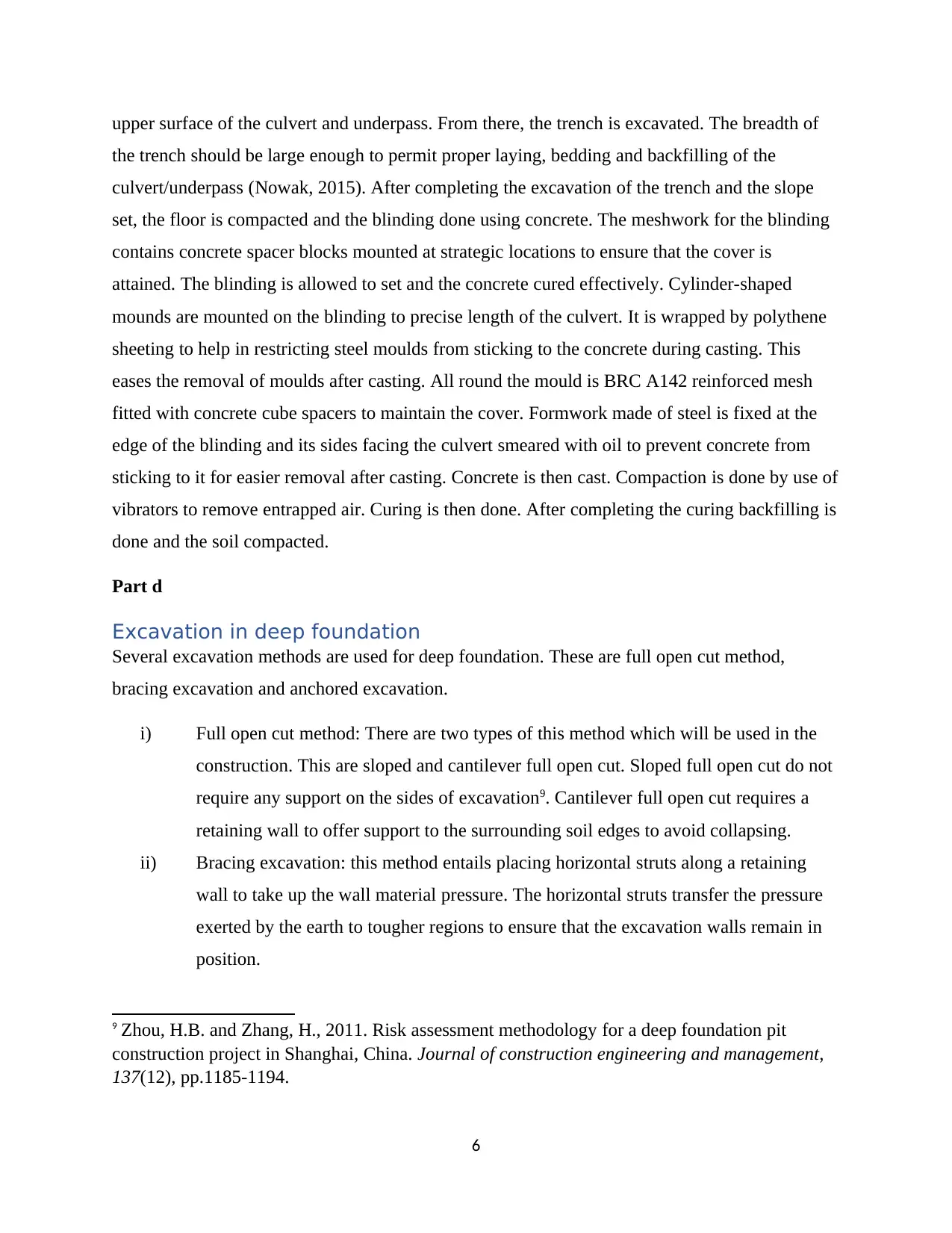
upper surface of the culvert and underpass. From there, the trench is excavated. The breadth of
the trench should be large enough to permit proper laying, bedding and backfilling of the
culvert/underpass (Nowak, 2015). After completing the excavation of the trench and the slope
set, the floor is compacted and the blinding done using concrete. The meshwork for the blinding
contains concrete spacer blocks mounted at strategic locations to ensure that the cover is
attained. The blinding is allowed to set and the concrete cured effectively. Cylinder-shaped
mounds are mounted on the blinding to precise length of the culvert. It is wrapped by polythene
sheeting to help in restricting steel moulds from sticking to the concrete during casting. This
eases the removal of moulds after casting. All round the mould is BRC A142 reinforced mesh
fitted with concrete cube spacers to maintain the cover. Formwork made of steel is fixed at the
edge of the blinding and its sides facing the culvert smeared with oil to prevent concrete from
sticking to it for easier removal after casting. Concrete is then cast. Compaction is done by use of
vibrators to remove entrapped air. Curing is then done. After completing the curing backfilling is
done and the soil compacted.
Part d
Excavation in deep foundation
Several excavation methods are used for deep foundation. These are full open cut method,
bracing excavation and anchored excavation.
i) Full open cut method: There are two types of this method which will be used in the
construction. This are sloped and cantilever full open cut. Sloped full open cut do not
require any support on the sides of excavation9. Cantilever full open cut requires a
retaining wall to offer support to the surrounding soil edges to avoid collapsing.
ii) Bracing excavation: this method entails placing horizontal struts along a retaining
wall to take up the wall material pressure. The horizontal struts transfer the pressure
exerted by the earth to tougher regions to ensure that the excavation walls remain in
position.
9 Zhou, H.B. and Zhang, H., 2011. Risk assessment methodology for a deep foundation pit
construction project in Shanghai, China. Journal of construction engineering and management,
137(12), pp.1185-1194.
6
the trench should be large enough to permit proper laying, bedding and backfilling of the
culvert/underpass (Nowak, 2015). After completing the excavation of the trench and the slope
set, the floor is compacted and the blinding done using concrete. The meshwork for the blinding
contains concrete spacer blocks mounted at strategic locations to ensure that the cover is
attained. The blinding is allowed to set and the concrete cured effectively. Cylinder-shaped
mounds are mounted on the blinding to precise length of the culvert. It is wrapped by polythene
sheeting to help in restricting steel moulds from sticking to the concrete during casting. This
eases the removal of moulds after casting. All round the mould is BRC A142 reinforced mesh
fitted with concrete cube spacers to maintain the cover. Formwork made of steel is fixed at the
edge of the blinding and its sides facing the culvert smeared with oil to prevent concrete from
sticking to it for easier removal after casting. Concrete is then cast. Compaction is done by use of
vibrators to remove entrapped air. Curing is then done. After completing the curing backfilling is
done and the soil compacted.
Part d
Excavation in deep foundation
Several excavation methods are used for deep foundation. These are full open cut method,
bracing excavation and anchored excavation.
i) Full open cut method: There are two types of this method which will be used in the
construction. This are sloped and cantilever full open cut. Sloped full open cut do not
require any support on the sides of excavation9. Cantilever full open cut requires a
retaining wall to offer support to the surrounding soil edges to avoid collapsing.
ii) Bracing excavation: this method entails placing horizontal struts along a retaining
wall to take up the wall material pressure. The horizontal struts transfer the pressure
exerted by the earth to tougher regions to ensure that the excavation walls remain in
position.
9 Zhou, H.B. and Zhang, H., 2011. Risk assessment methodology for a deep foundation pit
construction project in Shanghai, China. Journal of construction engineering and management,
137(12), pp.1185-1194.
6
⊘ This is a preview!⊘
Do you want full access?
Subscribe today to unlock all pages.

Trusted by 1+ million students worldwide
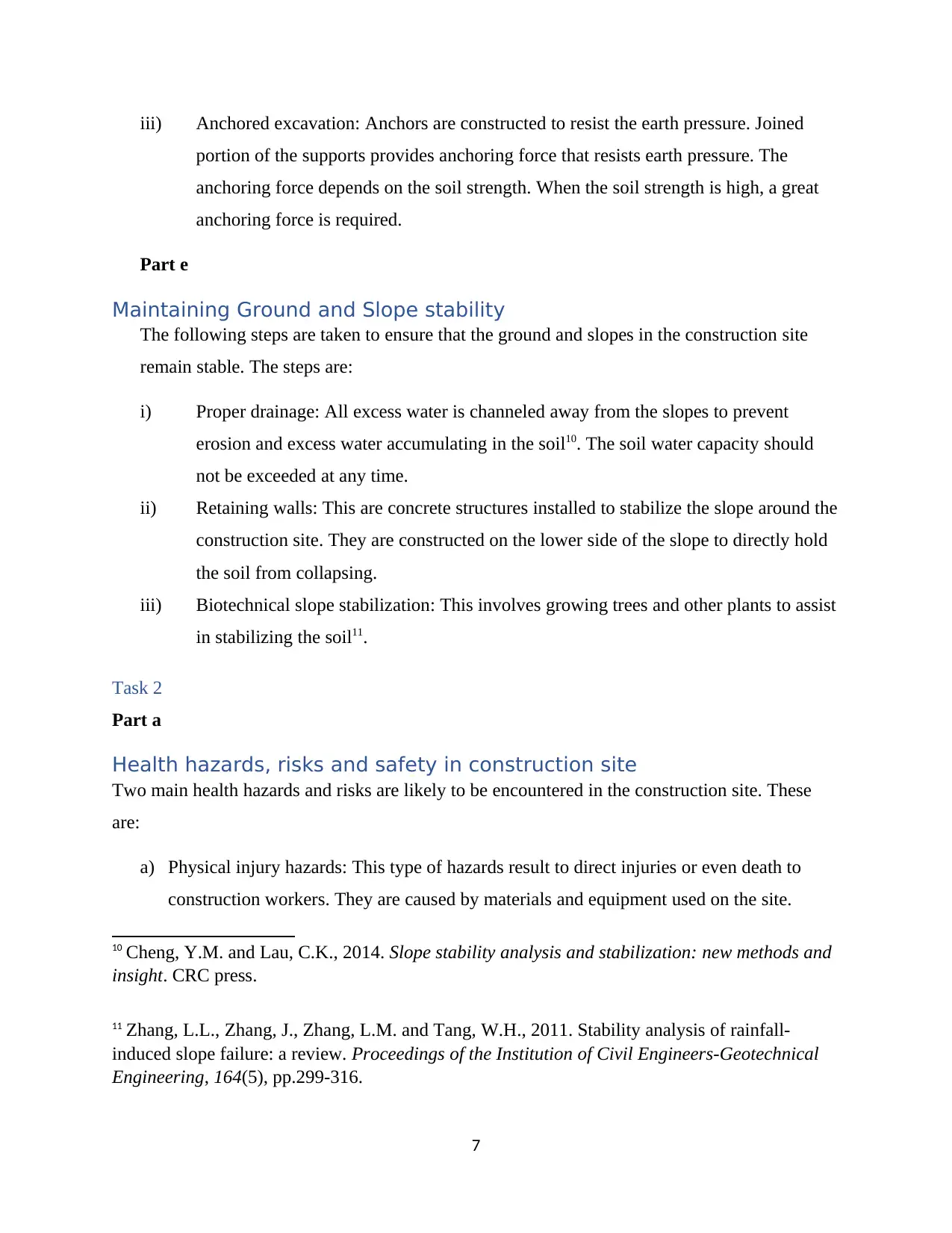
iii) Anchored excavation: Anchors are constructed to resist the earth pressure. Joined
portion of the supports provides anchoring force that resists earth pressure. The
anchoring force depends on the soil strength. When the soil strength is high, a great
anchoring force is required.
Part e
Maintaining Ground and Slope stability
The following steps are taken to ensure that the ground and slopes in the construction site
remain stable. The steps are:
i) Proper drainage: All excess water is channeled away from the slopes to prevent
erosion and excess water accumulating in the soil10. The soil water capacity should
not be exceeded at any time.
ii) Retaining walls: This are concrete structures installed to stabilize the slope around the
construction site. They are constructed on the lower side of the slope to directly hold
the soil from collapsing.
iii) Biotechnical slope stabilization: This involves growing trees and other plants to assist
in stabilizing the soil11.
Task 2
Part a
Health hazards, risks and safety in construction site
Two main health hazards and risks are likely to be encountered in the construction site. These
are:
a) Physical injury hazards: This type of hazards result to direct injuries or even death to
construction workers. They are caused by materials and equipment used on the site.
10 Cheng, Y.M. and Lau, C.K., 2014. Slope stability analysis and stabilization: new methods and
insight. CRC press.
11 Zhang, L.L., Zhang, J., Zhang, L.M. and Tang, W.H., 2011. Stability analysis of rainfall-
induced slope failure: a review. Proceedings of the Institution of Civil Engineers-Geotechnical
Engineering, 164(5), pp.299-316.
7
portion of the supports provides anchoring force that resists earth pressure. The
anchoring force depends on the soil strength. When the soil strength is high, a great
anchoring force is required.
Part e
Maintaining Ground and Slope stability
The following steps are taken to ensure that the ground and slopes in the construction site
remain stable. The steps are:
i) Proper drainage: All excess water is channeled away from the slopes to prevent
erosion and excess water accumulating in the soil10. The soil water capacity should
not be exceeded at any time.
ii) Retaining walls: This are concrete structures installed to stabilize the slope around the
construction site. They are constructed on the lower side of the slope to directly hold
the soil from collapsing.
iii) Biotechnical slope stabilization: This involves growing trees and other plants to assist
in stabilizing the soil11.
Task 2
Part a
Health hazards, risks and safety in construction site
Two main health hazards and risks are likely to be encountered in the construction site. These
are:
a) Physical injury hazards: This type of hazards result to direct injuries or even death to
construction workers. They are caused by materials and equipment used on the site.
10 Cheng, Y.M. and Lau, C.K., 2014. Slope stability analysis and stabilization: new methods and
insight. CRC press.
11 Zhang, L.L., Zhang, J., Zhang, L.M. and Tang, W.H., 2011. Stability analysis of rainfall-
induced slope failure: a review. Proceedings of the Institution of Civil Engineers-Geotechnical
Engineering, 164(5), pp.299-316.
7
Paraphrase This Document
Need a fresh take? Get an instant paraphrase of this document with our AI Paraphraser
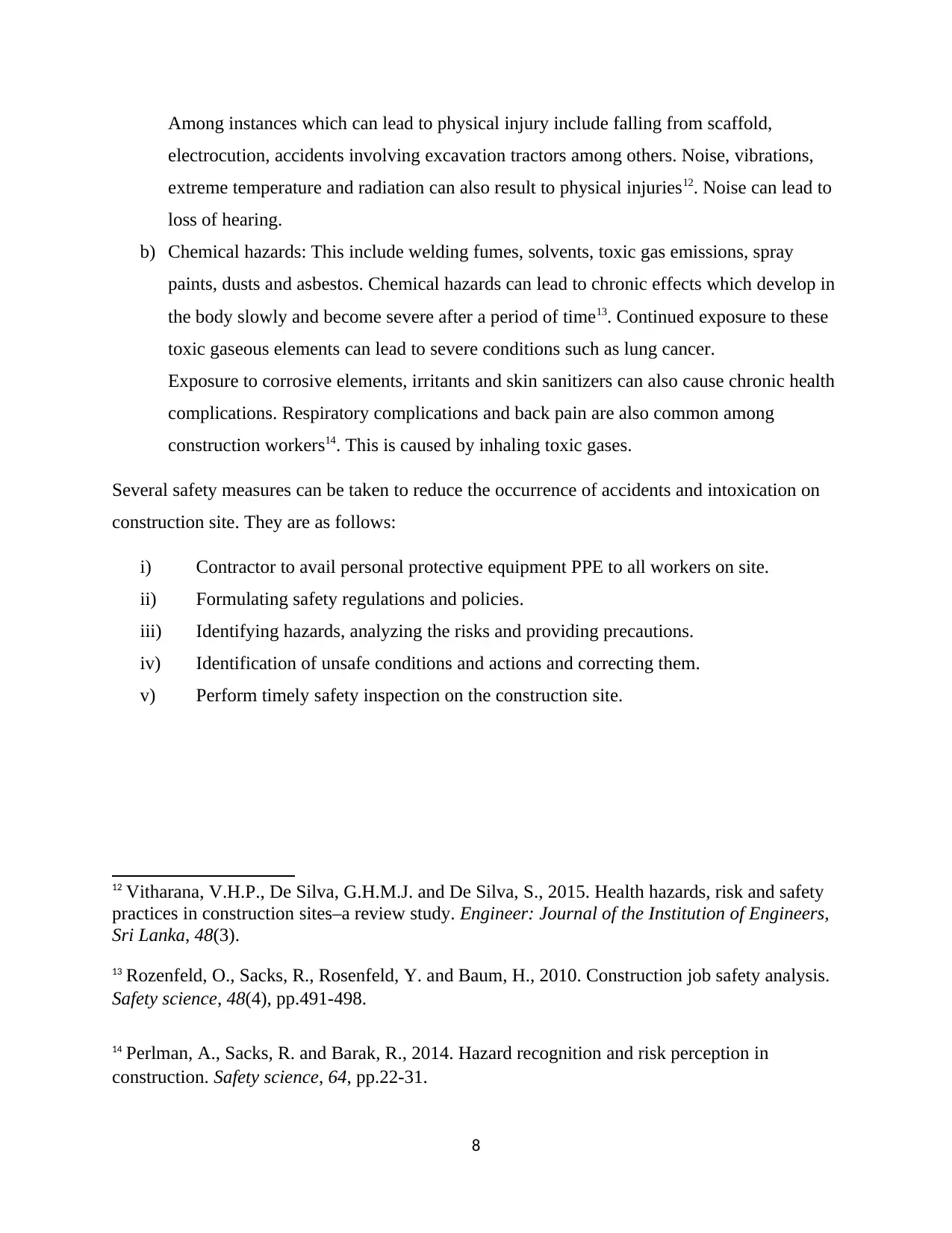
Among instances which can lead to physical injury include falling from scaffold,
electrocution, accidents involving excavation tractors among others. Noise, vibrations,
extreme temperature and radiation can also result to physical injuries12. Noise can lead to
loss of hearing.
b) Chemical hazards: This include welding fumes, solvents, toxic gas emissions, spray
paints, dusts and asbestos. Chemical hazards can lead to chronic effects which develop in
the body slowly and become severe after a period of time13. Continued exposure to these
toxic gaseous elements can lead to severe conditions such as lung cancer.
Exposure to corrosive elements, irritants and skin sanitizers can also cause chronic health
complications. Respiratory complications and back pain are also common among
construction workers14. This is caused by inhaling toxic gases.
Several safety measures can be taken to reduce the occurrence of accidents and intoxication on
construction site. They are as follows:
i) Contractor to avail personal protective equipment PPE to all workers on site.
ii) Formulating safety regulations and policies.
iii) Identifying hazards, analyzing the risks and providing precautions.
iv) Identification of unsafe conditions and actions and correcting them.
v) Perform timely safety inspection on the construction site.
12 Vitharana, V.H.P., De Silva, G.H.M.J. and De Silva, S., 2015. Health hazards, risk and safety
practices in construction sites–a review study. Engineer: Journal of the Institution of Engineers,
Sri Lanka, 48(3).
13 Rozenfeld, O., Sacks, R., Rosenfeld, Y. and Baum, H., 2010. Construction job safety analysis.
Safety science, 48(4), pp.491-498.
14 Perlman, A., Sacks, R. and Barak, R., 2014. Hazard recognition and risk perception in
construction. Safety science, 64, pp.22-31.
8
electrocution, accidents involving excavation tractors among others. Noise, vibrations,
extreme temperature and radiation can also result to physical injuries12. Noise can lead to
loss of hearing.
b) Chemical hazards: This include welding fumes, solvents, toxic gas emissions, spray
paints, dusts and asbestos. Chemical hazards can lead to chronic effects which develop in
the body slowly and become severe after a period of time13. Continued exposure to these
toxic gaseous elements can lead to severe conditions such as lung cancer.
Exposure to corrosive elements, irritants and skin sanitizers can also cause chronic health
complications. Respiratory complications and back pain are also common among
construction workers14. This is caused by inhaling toxic gases.
Several safety measures can be taken to reduce the occurrence of accidents and intoxication on
construction site. They are as follows:
i) Contractor to avail personal protective equipment PPE to all workers on site.
ii) Formulating safety regulations and policies.
iii) Identifying hazards, analyzing the risks and providing precautions.
iv) Identification of unsafe conditions and actions and correcting them.
v) Perform timely safety inspection on the construction site.
12 Vitharana, V.H.P., De Silva, G.H.M.J. and De Silva, S., 2015. Health hazards, risk and safety
practices in construction sites–a review study. Engineer: Journal of the Institution of Engineers,
Sri Lanka, 48(3).
13 Rozenfeld, O., Sacks, R., Rosenfeld, Y. and Baum, H., 2010. Construction job safety analysis.
Safety science, 48(4), pp.491-498.
14 Perlman, A., Sacks, R. and Barak, R., 2014. Hazard recognition and risk perception in
construction. Safety science, 64, pp.22-31.
8
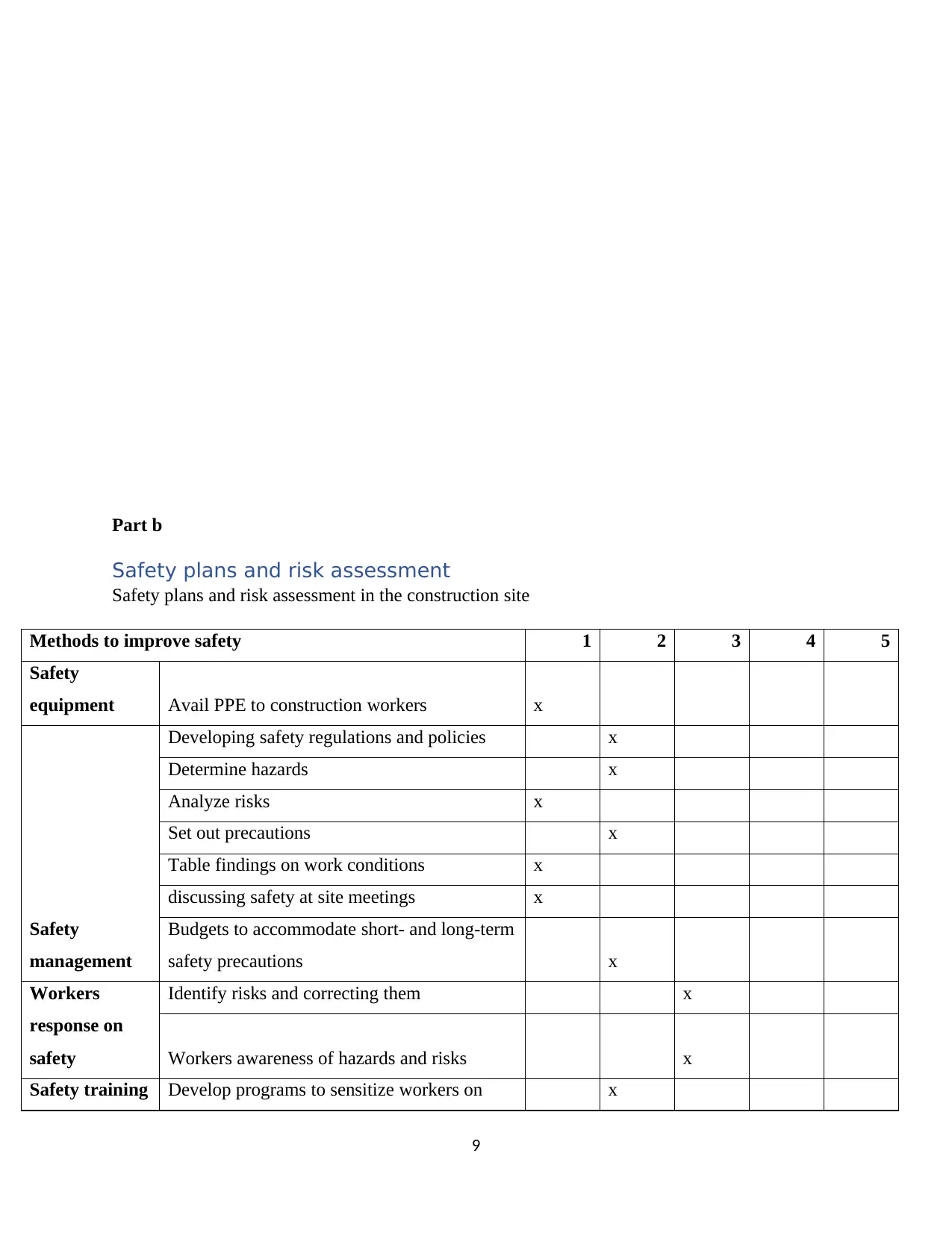
Part b
Safety plans and risk assessment
Safety plans and risk assessment in the construction site
Methods to improve safety 1 2 3 4 5
Safety
equipment Avail PPE to construction workers x
Safety
management
Developing safety regulations and policies x
Determine hazards x
Analyze risks x
Set out precautions x
Table findings on work conditions x
discussing safety at site meetings x
Budgets to accommodate short- and long-term
safety precautions x
Workers
response on
safety
Identify risks and correcting them x
Workers awareness of hazards and risks x
Safety training Develop programs to sensitize workers on x
9
Safety plans and risk assessment
Safety plans and risk assessment in the construction site
Methods to improve safety 1 2 3 4 5
Safety
equipment Avail PPE to construction workers x
Safety
management
Developing safety regulations and policies x
Determine hazards x
Analyze risks x
Set out precautions x
Table findings on work conditions x
discussing safety at site meetings x
Budgets to accommodate short- and long-term
safety precautions x
Workers
response on
safety
Identify risks and correcting them x
Workers awareness of hazards and risks x
Safety training Develop programs to sensitize workers on x
9
⊘ This is a preview!⊘
Do you want full access?
Subscribe today to unlock all pages.

Trusted by 1+ million students worldwide
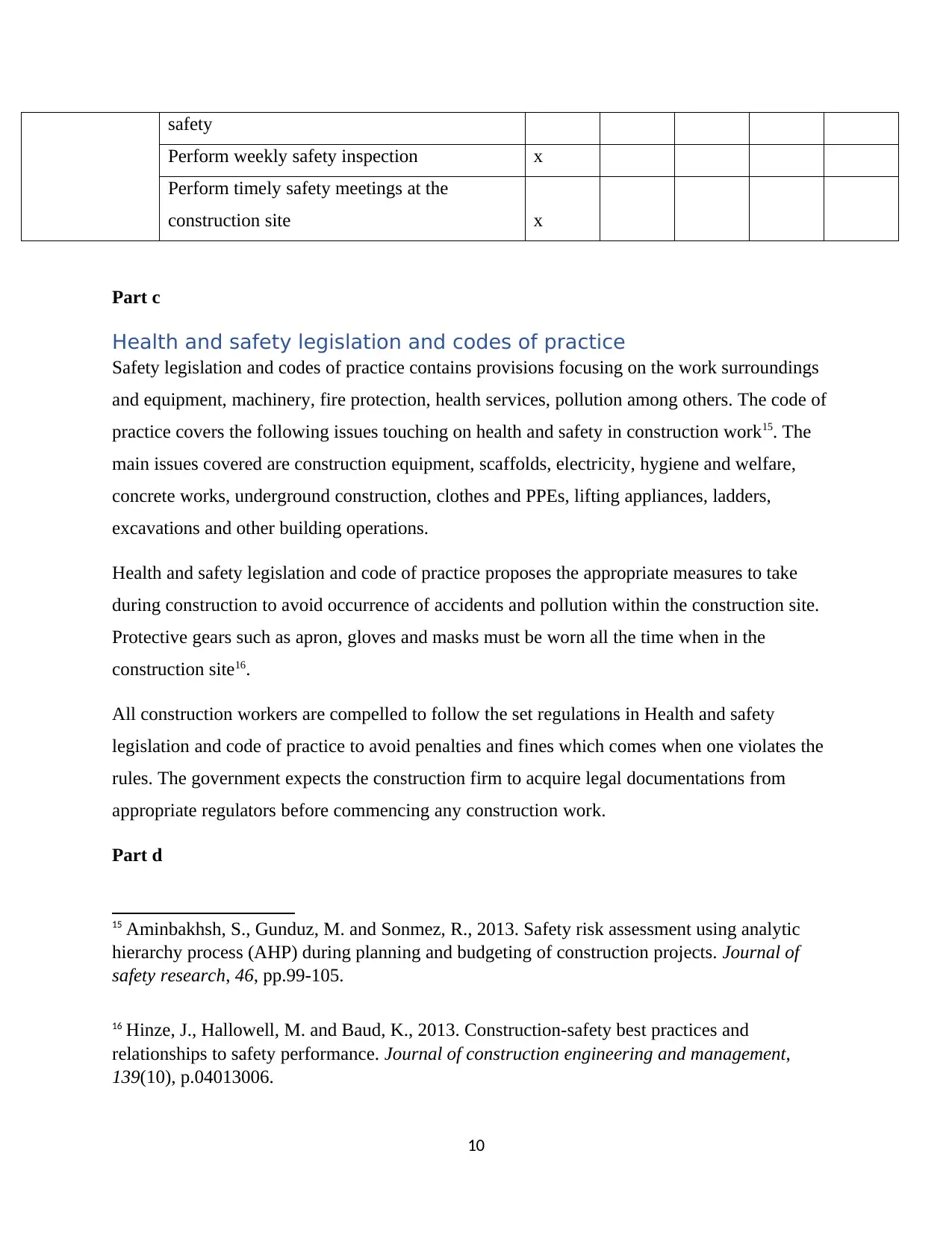
safety
Perform weekly safety inspection x
Perform timely safety meetings at the
construction site x
Part c
Health and safety legislation and codes of practice
Safety legislation and codes of practice contains provisions focusing on the work surroundings
and equipment, machinery, fire protection, health services, pollution among others. The code of
practice covers the following issues touching on health and safety in construction work15. The
main issues covered are construction equipment, scaffolds, electricity, hygiene and welfare,
concrete works, underground construction, clothes and PPEs, lifting appliances, ladders,
excavations and other building operations.
Health and safety legislation and code of practice proposes the appropriate measures to take
during construction to avoid occurrence of accidents and pollution within the construction site.
Protective gears such as apron, gloves and masks must be worn all the time when in the
construction site16.
All construction workers are compelled to follow the set regulations in Health and safety
legislation and code of practice to avoid penalties and fines which comes when one violates the
rules. The government expects the construction firm to acquire legal documentations from
appropriate regulators before commencing any construction work.
Part d
15 Aminbakhsh, S., Gunduz, M. and Sonmez, R., 2013. Safety risk assessment using analytic
hierarchy process (AHP) during planning and budgeting of construction projects. Journal of
safety research, 46, pp.99-105.
16 Hinze, J., Hallowell, M. and Baud, K., 2013. Construction-safety best practices and
relationships to safety performance. Journal of construction engineering and management,
139(10), p.04013006.
10
Perform weekly safety inspection x
Perform timely safety meetings at the
construction site x
Part c
Health and safety legislation and codes of practice
Safety legislation and codes of practice contains provisions focusing on the work surroundings
and equipment, machinery, fire protection, health services, pollution among others. The code of
practice covers the following issues touching on health and safety in construction work15. The
main issues covered are construction equipment, scaffolds, electricity, hygiene and welfare,
concrete works, underground construction, clothes and PPEs, lifting appliances, ladders,
excavations and other building operations.
Health and safety legislation and code of practice proposes the appropriate measures to take
during construction to avoid occurrence of accidents and pollution within the construction site.
Protective gears such as apron, gloves and masks must be worn all the time when in the
construction site16.
All construction workers are compelled to follow the set regulations in Health and safety
legislation and code of practice to avoid penalties and fines which comes when one violates the
rules. The government expects the construction firm to acquire legal documentations from
appropriate regulators before commencing any construction work.
Part d
15 Aminbakhsh, S., Gunduz, M. and Sonmez, R., 2013. Safety risk assessment using analytic
hierarchy process (AHP) during planning and budgeting of construction projects. Journal of
safety research, 46, pp.99-105.
16 Hinze, J., Hallowell, M. and Baud, K., 2013. Construction-safety best practices and
relationships to safety performance. Journal of construction engineering and management,
139(10), p.04013006.
10
Paraphrase This Document
Need a fresh take? Get an instant paraphrase of this document with our AI Paraphraser
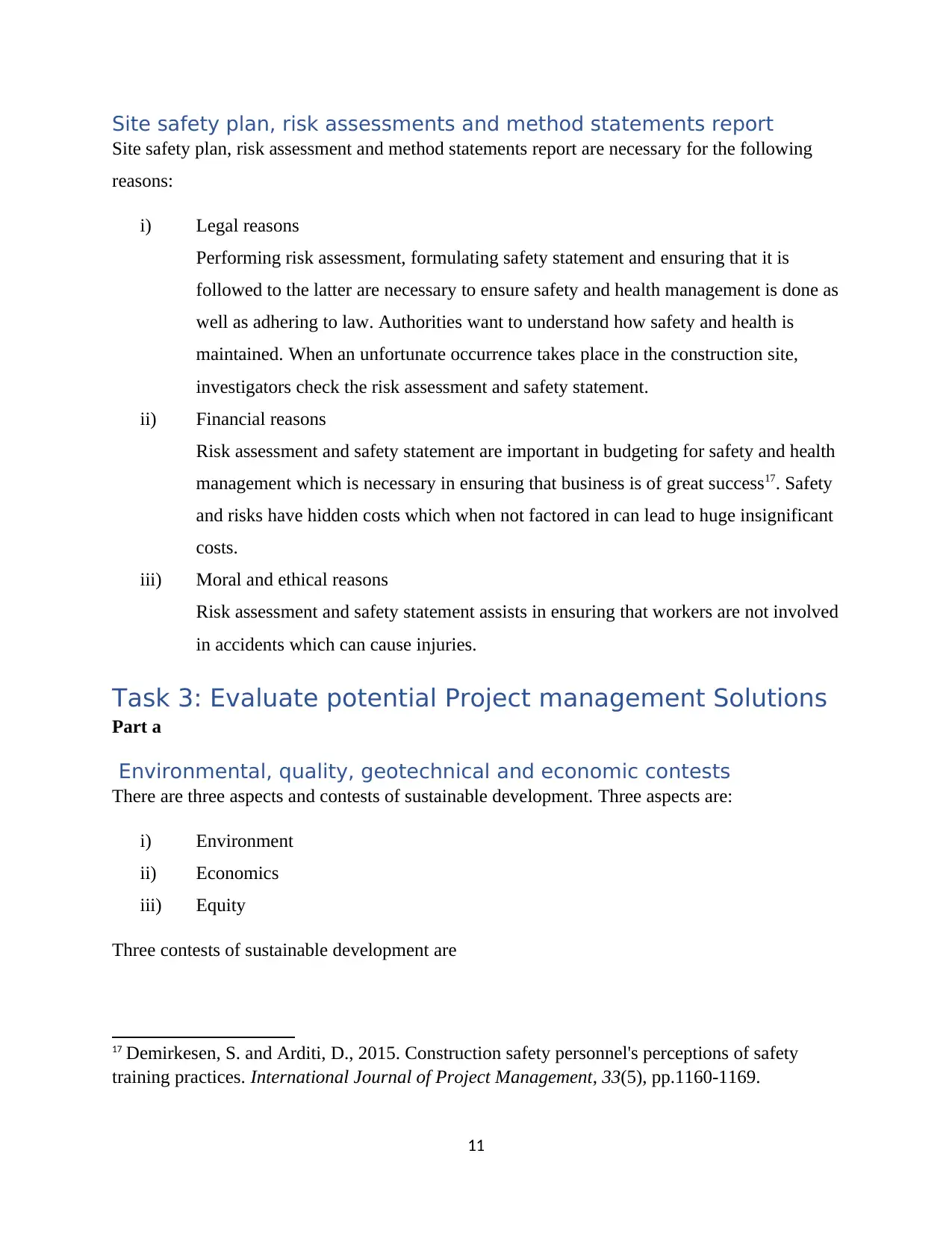
Site safety plan, risk assessments and method statements report
Site safety plan, risk assessment and method statements report are necessary for the following
reasons:
i) Legal reasons
Performing risk assessment, formulating safety statement and ensuring that it is
followed to the latter are necessary to ensure safety and health management is done as
well as adhering to law. Authorities want to understand how safety and health is
maintained. When an unfortunate occurrence takes place in the construction site,
investigators check the risk assessment and safety statement.
ii) Financial reasons
Risk assessment and safety statement are important in budgeting for safety and health
management which is necessary in ensuring that business is of great success17. Safety
and risks have hidden costs which when not factored in can lead to huge insignificant
costs.
iii) Moral and ethical reasons
Risk assessment and safety statement assists in ensuring that workers are not involved
in accidents which can cause injuries.
Task 3: Evaluate potential Project management Solutions
Part a
Environmental, quality, geotechnical and economic contests
There are three aspects and contests of sustainable development. Three aspects are:
i) Environment
ii) Economics
iii) Equity
Three contests of sustainable development are
17 Demirkesen, S. and Arditi, D., 2015. Construction safety personnel's perceptions of safety
training practices. International Journal of Project Management, 33(5), pp.1160-1169.
11
Site safety plan, risk assessment and method statements report are necessary for the following
reasons:
i) Legal reasons
Performing risk assessment, formulating safety statement and ensuring that it is
followed to the latter are necessary to ensure safety and health management is done as
well as adhering to law. Authorities want to understand how safety and health is
maintained. When an unfortunate occurrence takes place in the construction site,
investigators check the risk assessment and safety statement.
ii) Financial reasons
Risk assessment and safety statement are important in budgeting for safety and health
management which is necessary in ensuring that business is of great success17. Safety
and risks have hidden costs which when not factored in can lead to huge insignificant
costs.
iii) Moral and ethical reasons
Risk assessment and safety statement assists in ensuring that workers are not involved
in accidents which can cause injuries.
Task 3: Evaluate potential Project management Solutions
Part a
Environmental, quality, geotechnical and economic contests
There are three aspects and contests of sustainable development. Three aspects are:
i) Environment
ii) Economics
iii) Equity
Three contests of sustainable development are
17 Demirkesen, S. and Arditi, D., 2015. Construction safety personnel's perceptions of safety
training practices. International Journal of Project Management, 33(5), pp.1160-1169.
11
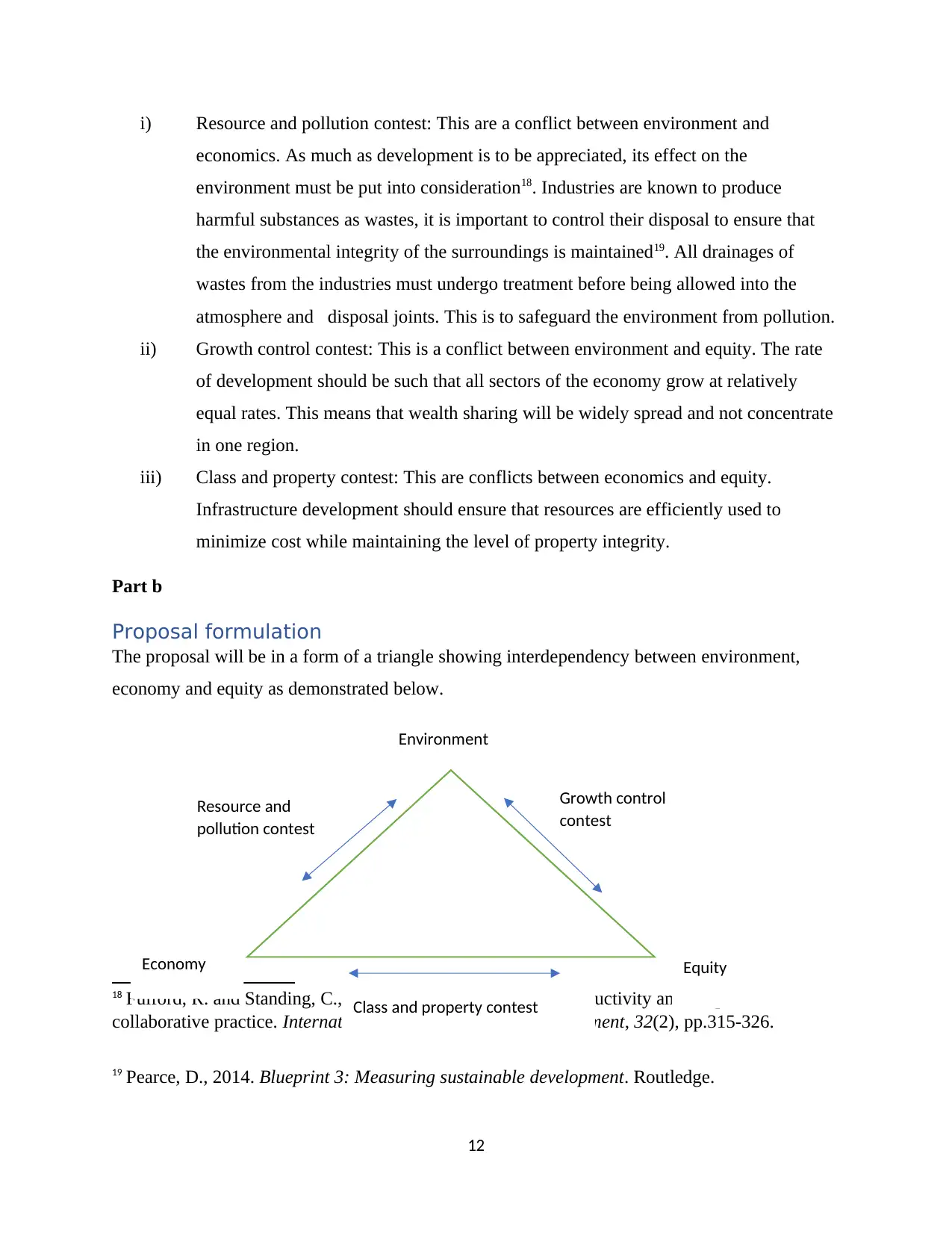
i) Resource and pollution contest: This are a conflict between environment and
economics. As much as development is to be appreciated, its effect on the
environment must be put into consideration18. Industries are known to produce
harmful substances as wastes, it is important to control their disposal to ensure that
the environmental integrity of the surroundings is maintained19. All drainages of
wastes from the industries must undergo treatment before being allowed into the
atmosphere and disposal joints. This is to safeguard the environment from pollution.
ii) Growth control contest: This is a conflict between environment and equity. The rate
of development should be such that all sectors of the economy grow at relatively
equal rates. This means that wealth sharing will be widely spread and not concentrate
in one region.
iii) Class and property contest: This are conflicts between economics and equity.
Infrastructure development should ensure that resources are efficiently used to
minimize cost while maintaining the level of property integrity.
Part b
Proposal formulation
The proposal will be in a form of a triangle showing interdependency between environment,
economy and equity as demonstrated below.
18 Fulford, R. and Standing, C., 2014. Construction industry productivity and the potential for
collaborative practice. International Journal of Project Management, 32(2), pp.315-326.
19 Pearce, D., 2014. Blueprint 3: Measuring sustainable development. Routledge.
12
Environment
EquityEconomy
Class and property contest
Growth control
contest
Resource and
pollution contest
economics. As much as development is to be appreciated, its effect on the
environment must be put into consideration18. Industries are known to produce
harmful substances as wastes, it is important to control their disposal to ensure that
the environmental integrity of the surroundings is maintained19. All drainages of
wastes from the industries must undergo treatment before being allowed into the
atmosphere and disposal joints. This is to safeguard the environment from pollution.
ii) Growth control contest: This is a conflict between environment and equity. The rate
of development should be such that all sectors of the economy grow at relatively
equal rates. This means that wealth sharing will be widely spread and not concentrate
in one region.
iii) Class and property contest: This are conflicts between economics and equity.
Infrastructure development should ensure that resources are efficiently used to
minimize cost while maintaining the level of property integrity.
Part b
Proposal formulation
The proposal will be in a form of a triangle showing interdependency between environment,
economy and equity as demonstrated below.
18 Fulford, R. and Standing, C., 2014. Construction industry productivity and the potential for
collaborative practice. International Journal of Project Management, 32(2), pp.315-326.
19 Pearce, D., 2014. Blueprint 3: Measuring sustainable development. Routledge.
12
Environment
EquityEconomy
Class and property contest
Growth control
contest
Resource and
pollution contest
⊘ This is a preview!⊘
Do you want full access?
Subscribe today to unlock all pages.

Trusted by 1+ million students worldwide
1 out of 17
Related Documents
Your All-in-One AI-Powered Toolkit for Academic Success.
+13062052269
info@desklib.com
Available 24*7 on WhatsApp / Email
![[object Object]](/_next/static/media/star-bottom.7253800d.svg)
Unlock your academic potential
Copyright © 2020–2025 A2Z Services. All Rights Reserved. Developed and managed by ZUCOL.




